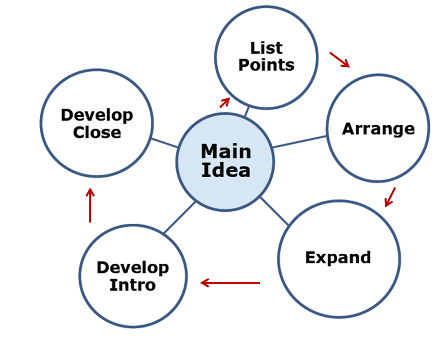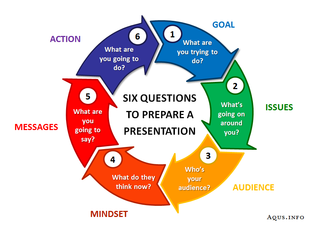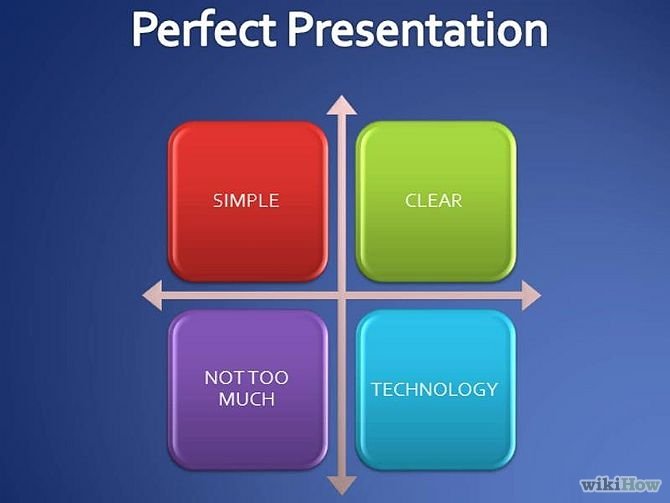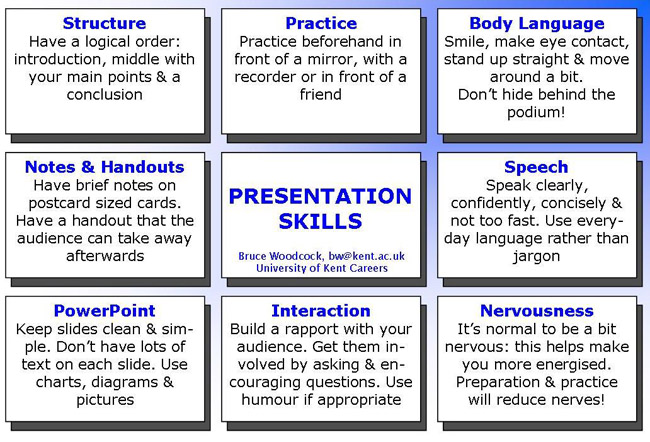At a glance it may seem that preparing a presentation is more or less similar to writing an essay: there are the same basic parts, the same attention paid to the logical progression of ideas and smooth transition between them. However, there is one huge difference – a presentation is meant to be uttered aloud, not read by the eye, which leads to difference in structure, language and many other aspects. This guide will help you find your way around both preparing the written part of your presentation and readying yourself to deliver it in front of an audience in a manner you need.
Presentation Structure
Similarly to many other types of writing, your typical presentation consists of three parts:
- Introduction;
- Body;
- Conclusion.
Source: https://www.youtube.com/watch?v=nMGJJFnnbFk
They are, however, usually not supposed to be written in the same order – in absolute majority of cases it is advisable to start with the body, follow up with the conclusion and write the introduction after everything else is ready. You may, of course, start with an introduction, but chances are, you will have to rewrite it after you’ve dealt with the rest of the presentation.
Preparations and Planning
“If you fail to plan, you plan to fail” – however clichéd this phrase may sound, it is still true. If you don’t write a plan for an essay, the worst that can happen is that you will have to rewrite it. Failing in front of audience, like in case of presentation, is much less pleasant.

Source: http://www.devenshah.net/wp-content/uploads/2010/11/Preparing-Your-Presentation.png
First of all, you should decide what you are going to talk about: what is the main goal of your presentation, which points you will cover and which details you will use to support your point of view.
In presentations, like in communication in general, it is a good rule of a thumb to stick to threes. There are many reasons to do so:
- Three possesses a strong symbolic and cultural meaning. An argument supported by three points looks carefully arranged and symmetric, which is not the least important thing to think about;
- There is a neurological reason why this number is used so often – human brain finds it relatively easy to grasp three points in a short period of time. Two is too few to form any opinion, and with four and more points a part of your audience will get progressively more and more confused;
- Because of it all, three points are easier to remember, which means that you may be more sure that your audience is going to take something out of your presentation with them.
Source: https://www.youtube.com/watch?v=-zFK1RJqMO8
The most common way of organizing the body of presentation is, broadly speaking, dividing it into three segments to answer three consecutive questions:
- “What?” – Here you introduce your main idea;
- “Why?” – Think about the first, most obvious question that should appear after the audience hears about “what?” and try to answer it, for example, “Why is it so important?” Thus your presentation is going to flow logically along the same lines as the thought process of those who listen to it;
- “How?” – The next natural question that arises should be something along the lines of “How is this to be achieved?”, and again, your presentation should anticipate it.
It should be noted, however, that these questions and their succession are purely approximate and exemplary – it is not a rule set in stone that isn’t to be broken. If you have an idea with three supporting facts that are of equal importance, feel free to use them – just make sure to organize it all logically.
And again, make use of the rule of threes – try to back up each of your main points with three supporting ideas.
Writing the Body
Now that you’ve decided what you are going to talk about, it is time to actually write it down. Following the plan you’ve laid out, cover each point, using the necessary proofs, such as facts and statistics, when appropriate.

Source: http://www.andyeklund.com/wp-content/uploads/2013/05/6a00e55079f2668833017ee40f1e88970d-320wi.png
If you are using visual aids, such as PowerPoint slides, prepare them at this point and make sure they don’t contradict what you say and follow each other in the same order as you cover the points.
Probably the most important issue for you to cope with is logical transition between parts of presentation. You can, of course, simply say “Now I am moving on to the next point…”, but it sounds awkward and a bit helpless. If you really want to make a positive impression, you should take care to prepare transitions between logical parts of the presentation beforehand and make sure to memorize them. If you forget some aspects you want to cover, you can always consult your notes and visual aids; if you forget how the parts of the presentation are connected, you may get into trouble.
Editing the Body
Don’t expect to get everything right the first time around. After you’ve completed writing the body paragraphs, it is time for editing them – which is, by the way, a good reason not to be perfectionistic when you write them. You can always edit them later – at first you simply have to put your thoughts and ideas into writing.

Ideally, you should leave your presentation alone for a little while before attempting editing – at least for a day, but feel free to take as long a break as your deadline allows you. This way you will be able to see what you’ve written without prejudice, and numerous small and large mistakes and inconsistencies will suddenly become obvious.
But what exactly do you need to do while editing?
- Check you language and choice of words for consistency and appropriateness. Can you be sure that the entirety of your audience is familiar with the terminology you use? Does the language correspond to the occasion? Do you use any out-of-place or slang words?
- Is your presentation easily understood? Remember, you are going to deliver it aloud, and the listeners won’t have anything to assist them in understanding you but visual aids (which are optional). You are not doing a presentation to impress somebody but to impart information. Thus, if you find yourself using long and obscure words that can be easily misheard, try to replace them with shorter and simpler synonyms.
- Check for run-on sentences. Again, your audience will listen to you, not read what you have written, so make sentences short and simple to avoid confusion and boredom.
- Make sure you use visual aids to a limit. Many presenters treat them as a necessary evil and accompaniment to their delivery, losing an opportunity to use an additional powerful instrument to influence the audience. Think about additional visual imagery you can use to grasp the audience’s attention at key points and how you can introduce it in your presentation.
- Pay special attention to checking all your visual aids and printed materials for grammar and spelling mistakes. Nothing kills the seriousness of the moment like a conspicuous misspelling on a particularly important slide.
- Practice the delivery, preferably in front of an audience. Ask a friend to sit through your presentation and request objective criticism.
Writing a Conclusion
There are no hard rules as to how one is supposed to conclude one’s presentation; there are many ways to finish it, yet none of them are surefire. There are, however, some guidelines following which is usually a good idea:
- Make sure you provide the audience with concise yet exhaustive summary of what you’ve said. It will consolidate the impression you’ve made and remind them of points they might have forgotten or missed;
- Make it obvious that you’ve come to the end of your presentation – don’t let it end abruptly. The audience should be aware of the fact that you are making some final statements so that even those who got distracted halfway through start paying attention once again and at least grasp the gist of what you say;
- Don’t forget to thank the audience for their time and encourage discussion. Ask if they have any questions; if they don’t, take an active stance: ask some leading questions or raise some issues for discussion (make sure you’ve prepared them in advance to be ready to this eventuality).
Source: https://www.youtube.com/watch?v=RHX-xnP_G5s
Writing an Introduction
Introduction is the most important part of any piece of writing; but its importance increases tenfold when you talk to a live audience. If you fail to grasp its attention from the get-go, you may just as well pack and go home – no matter how fascinating the rest of the presentation is, it is very unlikely that you will be able to recapture the listeners’ attention.
Source: https://www.youtube.com/watch?v=NXqUWHgBrCE
Read what you’ve already written and try to think how you can lead the audience into the topic. There are multiple methods of doing so:
- A bit of humor. A joke is an excellent way to get closer to the audience, get their brains moving and give them hope you are not going to bore them to death. You should, however, make sure that it is, firstly, relevant to the topic, secondly, actually funny.
- Engaging with the audience. This method is used to stir the audience up from the very beginning, make them take active participation instead of passively expecting what you have to say. Ask them some questions, give them a short exercise, encourage them to share their opinion on something. However, there is a downside – it may rile them up so much that it will be difficult to concentrate on listening later on. If you doubt your ability to control the audience, don’t resort to it.
- State some interesting/fascinating/shocking fact or statistic. It is especially effective when what you report isn’t widely known.
- Tell a story. Humans are hardwired to pay attention to stories, so make use of it. Just make sure that the story is short, interesting and relevant to the topic.
- If someone has already said something gripping on your topic, why not use it? A powerful quote, especially if it isn’t too hackneyed and overly dramatic for the purpose at hand, is a good way to attract the audience’s attention.
- An example. You may either describe a situation illustrating the central issue of your presentation or use some visual aids to make the example more impressive.
These are just some of the possible introductions; when all is said and done, you are only limited by your own ingenuity. Use whatever you feel is going to work best in the current situation.
Some General Remarks
A presentation is very different from most other written works – first of all, it is not so much a text as a unity of written text, visual aids, body language, interaction with the audience and your own intonation. When writing it, you should take into account how the text proper corresponds with all the other elements.

Source: https://www.kent.ac.uk/careers/pics/Presentation-skills.jpg
Here are some additional tips that may help you:
- 10-20-30 rule. It is a useful rule of a thumb by Guy Kawasaki from Apple. According to it, your slideshow should contain no more than 10 slides, last no longer than 20 minutes and use font size no less than 30 point. Following it will greatly limit the amount of information you may cram both into the entire presentation and into each particular slide, forcing you to trim the fat and leave only what is really important. If anybody is interested in additional information, you may create a handout and distribute it after the presentation.
- Time the entire thing. Don’t guesstimate how long each slide and the presentation in general are going to take, use a timer. Adjust the text accordingly if necessary.
- Check the pronunciation. If you use obscure, foreign or just plain difficult words, at least make sure you know how to pronounce them before you start.
- Prepare the tone of voice and body language in advance. If you don’t trust yourself to spontaneously use the right gestures and intonations, mark where to do so beforehand.
A presentation may look like an intimidating task at first, but it is all a matter of planning and deliberation. Break it up into parts, deal with each one separately – and nothing can be easier.